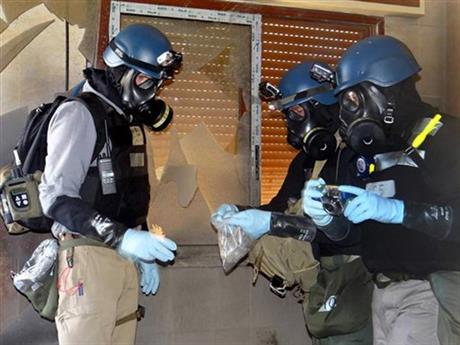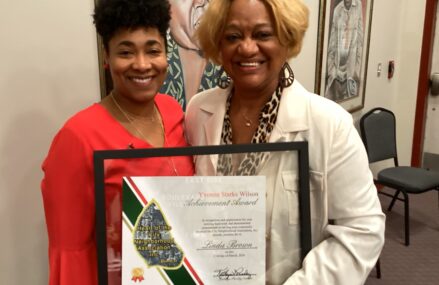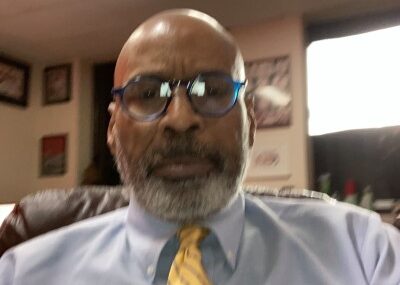
By KARIN LAUB
FILE — In this Thursday, Aug. 29, 2013 file photo, a citizen journalism image provided by the Local Committee of Arbeen which has been authenticated based on its contents and other AP reporting, shows members of the UN investigation team take samples from the ground in the Damascus countryside of Zamalka, Syria. The dismantling of Syria’s chemical weapons stockpile is under way, but the mission faces multiple challenges, from an ambitious deadline and a raging civil war that threatens inspectors’ safety. It also has far-reaching political consequences, giving a political boost to President Bashar Assad and further alienating the rebels. (AP Photo/Local Committee of Arbeen, File)
BEIRUT (AP) — The destruction of Syria’s chemical weapons stockpile is well underway, and the agency overseeing it — the Organization for the Prohibition of Chemical Weapons — has won a Nobel Peace Prize. But despite global praise and a smooth start, the mission faces difficult challenges, from tight deadlines to safety risks for inspectors trying to get to sites near fighting. There’s also political fallout. The decision to make Syrian President Bashar Assad a partner in destroying the stockpile appears to have restored some of his legitimacy and boosted his chances of staying in power longer, while angering his opponents who now balk at attending political transition talks the U.S. hopes will begin in November.
A look at the mission:
WHAT HAPPENS NEXT?
Syria became a full member of the OPCW on Monday. By Oct. 27, Syria must submit a plan for the destruction of its stockpile. On Nov. 1, OPCW inspectors must complete verification of the inventory and render production, mixing and filling facilities unusable. By Nov. 15, the OPCW must adopt a plan for destroying the stockpile, aiming for completion by mid-2014.
HOW BIG IS SYRIA’S CHEMICAL ARSENAL?
Syria has briefed the OPCW, which is not releasing the information. The U.N. says Syria has about 1,000 metric tons of chemical weapons materials. Former OPCW official Ralf Trapp and disarmament expert Jean-Pascal Zanders believe Syria has about 300 metric tons of sulfur mustard, a blistering agent, and about 700 metric tons of the nerve agents sarin and VX. The OPCW won’t say how much of the nerve agent is weapons-ready, but suggests much is in precursor form, as separate components.
HOW MANY SITES?
Ahmet Uzumcu, the head of the OPCW, was quoted as saying Monday that his team has visited five of at least 20 sites. U.S. chemical weapons nonproliferation expert Amy Smithson said that among the sites are four production facilities near the towns of Safira, Khan Abu Shamat, Homs and Hama; six storage facilities near Safira, Homs and Hama and the towns of Furqlus, Latakia and Palmyra; and a research and development site in Damascus.
HOW DANGEROUS IS THE MISSION?
Sixty OPCW inspectors and U.N. staff are on the ground, and the team is to grow to 100. The OPCW chief told the BBC that one abandoned site was in rebel-held territory and routes to others led through it, preventing access. The U.N. is to arrange safe passage for inspectors, but rebels have not promised cooperation. The risks were illustrated when regime warplanes bombed the rebel-held town of Safira last week, near one of the likely chemical weapons facilities. Over the weekend, two mortar shells struck 300 meters (yards) from the Damascus hotel where the inspectors are staying.
HOW REALISTIC IS THE TIMETABLE?
Trapp, Zanders and Smithson said destroying munitions and machinery with blow torches, sledgehammers and bulldozers by Nov. 1 is achievable. Destroying the chemical arsenal will be more complicated. Steven Bucci, a former U.S. defense official, said the target dates are “wildly optimistic,” noting that it is taking the U.S. and Russia decades to destroy much larger stockpiles.
Trapp and Zanders said Syria’s chemical weapons threat can be eliminated relatively quickly once the mustard gas, the weapons-ready nerve agents and the means of delivering them are all destroyed.
HOW WILL THE STOCKPILE BE DESTROYED?
By Nov. 1, inspectors are to have visited each site, take photos, tag and seal items, and destroy specialized production, mixing and filling equipment and unfilled munitions. In the next phase, the chemicals will be destroyed. Neutralization with chemical agents is preferred, especially with precursors, the OPCW said. Precursors are easier to destroy than weapons-ready materials. Mustard gas can be neutralized with strong alkaline water or bleach. Mobile units will likely be deployed for some of the destruction, but some parts of the arsenal may shipped out of the country, Trapp and Smithson said.
IS THE REGIME COOPERATING?
The OPCW needs Syrian cooperation to destroy the stockpiles, and the mission could falter if the regime collapses before mid-2014.
U.S. Secretary of State John Kerry said the regime deserves credit for “complying rapidly,” though he insisted Assad has lost the legitimacy to rule.
Smithson, of the Center for Nonproliferation Studies, a U.S. think tank, said the regime appears to be cooperating but has a “very sorry track record” on working with nuclear inspectors. She said it is easier to hide chemical and biological weapons than a nuclear program.
Trapp said satellites would likely detect serious attempts to cheat. Under the OPCW’s rules, the Syrians would have to allow inspection of any site that raises suspicions.
WILL PERPETRATORS ESCAPE PUNISHMENT?
The U.N. is documenting alleged war crimes by both sides in the civil war, and future prosecution is possible. The West holds the regime responsible for deadly Aug. 21 nerve gas attacks near Damascus, while Assad blames the rebels. A match between the types of weapons Syria has declared to the OPCW and weapons remnants found previously by U.N. inspectors at the site of the Damascus attacks could build a stronger case against the regime.
WHAT DOES THIS MEAN FOR RIDDING THE WORLD OF CHEMICAL WEAPONS?
North Korea, Angola, Egypt and South Sudan haven’t signed the convention. Israel and Myanmar have signed but not ratified. North Korea is believed to have 3,000 to 5,000 metric tons of chemical weapons materials, Zanders said, adding that he is not aware of a chemical warfare capacity in either Egypt or Israel.
Seven countries have declared stockpiles: Russia, the U.S. India, Albania, Libya and a “state party” believed to be South Korea. The U.S. and Russia started out with a combined stockpile of more than 70,000 metric tons and have so far destroyed about 80 percent.


